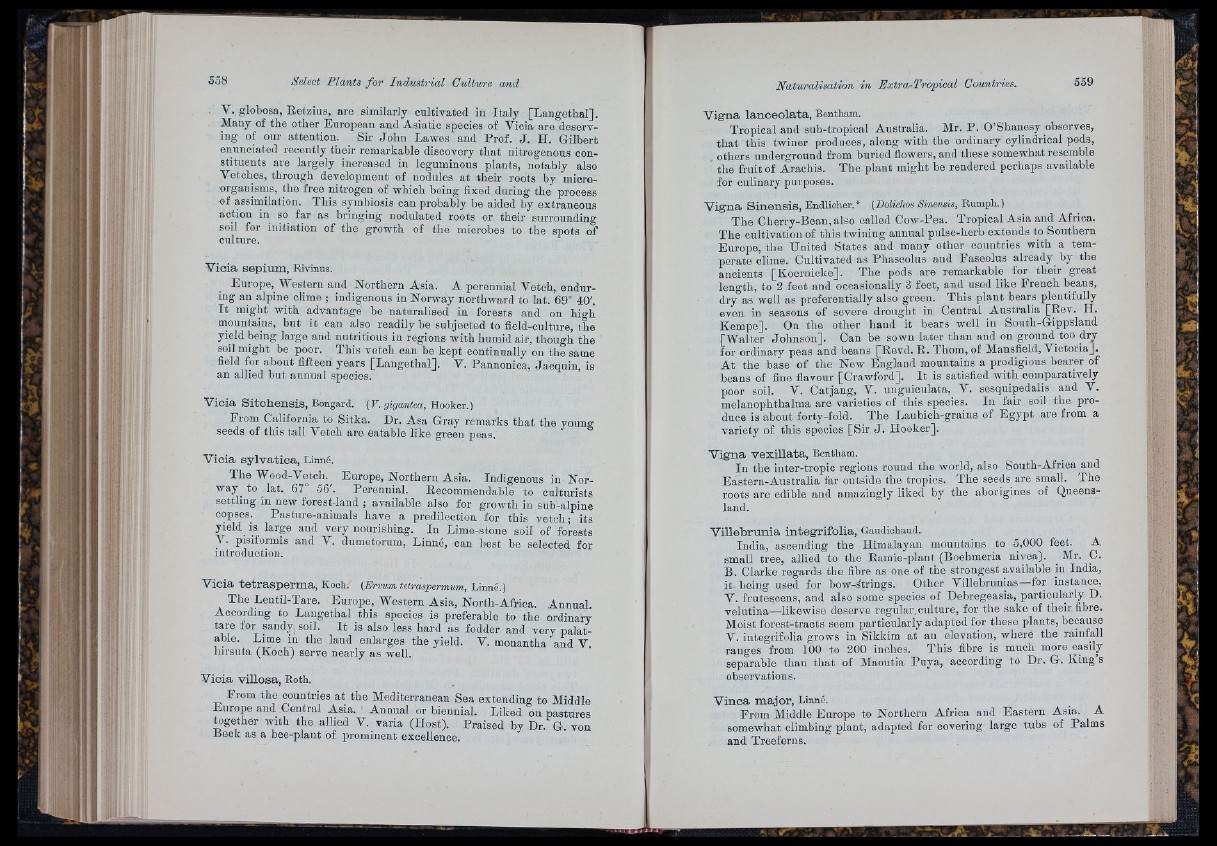
V. globosa, Eetzius, are similarly cultivated in Ita ly [Langethal].
Many of the other European and Asiatic species of Vicia are deserving
of our attention. Sir Jo h n Lawes and Prof. J . H. Gilbert
enunciated recently their remarkable discovery th a t nitrogenous constituents
are largely increased in leguminous plants, notably also
Vetches, throngh development of nodules a t their roots by 'microorganisms,
the free nitrogen of which being fixed during the process
of assirnilation. This symbiosis can probably be aided by extraneous
action in so far as bringing nodulated roots or their surrounding
soil for initiation of the growth of the microbes to the spots of
culture.
Vicia sepium, Rivinus.
Europe, Western and Northern Asia. A perennial Vetch, enduring
an alpine clime ; indigenous in Norway northward to lat. 69° 40'.
I t might with advantage he naturalised in forests and on high
mountains, but it can also readily be subjected to field-culture, the
yield being large and nutritions in regions with humid air, though the
soil might be poor. This vetch can be kept continually on the same
field for about fifteen years [Langethal]. V. Pannonica, Jacquin, is
an allied but annual species.
Vicia Sitchensis, Bongard. (V. gigantea, Hooker.)
From California to Sitka. Dr. Asa Gray remarks th a t the youne
seeds of this tall Vetch are eatable like green peas.
Vicia sylvatica, Linné.
The Wood-Vetch. Europe, Northern Asia. Indigenous in Norway
to lat. 67° 56'. Perennial. Eecommendable to culturists
settling in new forestJand ; available also for growth in sub-alpine
copses. Pasture-animals have a predilection for this vetch; its
yield^ is large and very nourishing. In Lime-stone soil of forests
y . pisiformis and V. dumetorum, Linné, can best be selected for
introduction.
Vicia tetrasperma, Koch. (Brvum tetraspermum, Linné.)
The Leutil-Tare. Europe, Western Asia, North-Africa. Annual.
According to Langethal this species is preferable to the ordinar/
tare for sandy soil. I t is also less hard as fodder and very palatable.
Lime in the land enlarges the yield. V. monantha and V.
hirsuta (Koch) serve nearly as well.
Vicia villosa, Roth.
From the countries a t the Mediterranean Sea extending to Middle
Europe and Central Asia. Annual or biennial. Liked ou pastures
together with the allied V. varia (Host). Praised by Dr. G. von
Beck as a bee-plant of prominent excellence.
Vigna lanceolata, Bentham.
Tropical and sub-tropical Australia. Mr. P . O’Shanesy observes,
th a t this twiner produces, along with the ordinary cylindrical pods,
others underground from buried flowers, and these somewhat resemble
the fruit of Arachis. The plant might be rendered perhaps available
for culinary purposes.
Vigna Sinensis, Endlicher.* (Dolichos Sinensis, Rumph.)
The Cherry-Bean, also called Cow-Pea. Tropical Asia and Africa.
The cultivation of this twining annnal pulse-herb extends to Southern
Europe, the United States and many other countries with a temperate
clime. Cultivated as Phaseolus and Faseolus already by the
ancients [Koernicke]. The pods are remarkable for their great
length, to 2 feet and occasionally 3 feet, and used like French beans,
dry as well as preferentially also green. This plant bears plentifully
even in seasons of severe drought in Central Australia [Rev. H.
Kempe]. On the other hand it bears well in South-Gippsland
[Walter Johnson]. Can be sown later than and on ground too dry
for ordinary peas and beans [Revd. E. Thom, of Mansfield, Victoria].
A t the base of th e New England mountains a prodigious bearer of
beans of fine flavour [Crawford]. I t is satisfied with comparatively
poor soil. V. Catjang, V. unguioulata, V. sesquipedalis and V.
melanophthalma are varieties of this species. In fair soil the produce
is about forty-fold. The Laubich-grains of E gypt are from a
variety of this species [Sir J . Hooker].
Vigna vexillata, Bentham.
In the inter-tropic regions round the world, also South-Africa and
Eastern-Australia far outside the tropics. The seeds are small. The
roots are edible and amazingly liked by the aborigines of Queensland.
Villetarunia integrifolia, Gaudichaud.
India, ascending the Himalayan mountains to o,000 feet. A
small tree, allied to the Ramie-plant (Boehmeria nivea). _ Mr. C.
B. Clarke regards the fibre as one of the strongest available in India,
it being used for bow-étrings. Other Villebrunias—for instance,
V. frutescens, and also some species of Debregeasia, particularly D.
velutina—likewise deserve regular.culture, for the sake of their fibre.
Moist forest-tracts seem particularly adapted for these plants, because
V. integrifolia grows in Sikkim at an elevation, where the rainfall
ranges from 100 to 200 inches. This fibre is much more easily
separable than th a t of Maoutia Puya, according to Dr. G. King’s
observations.
Vinca major, Linné.
From Middle Europe to Northern Africa and Eastern Asia. A
somewhat climbing plant, adapted for covering large tubs of Palms
and Treeferus.